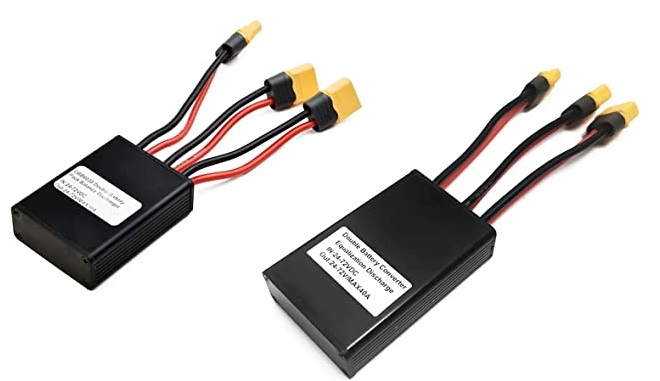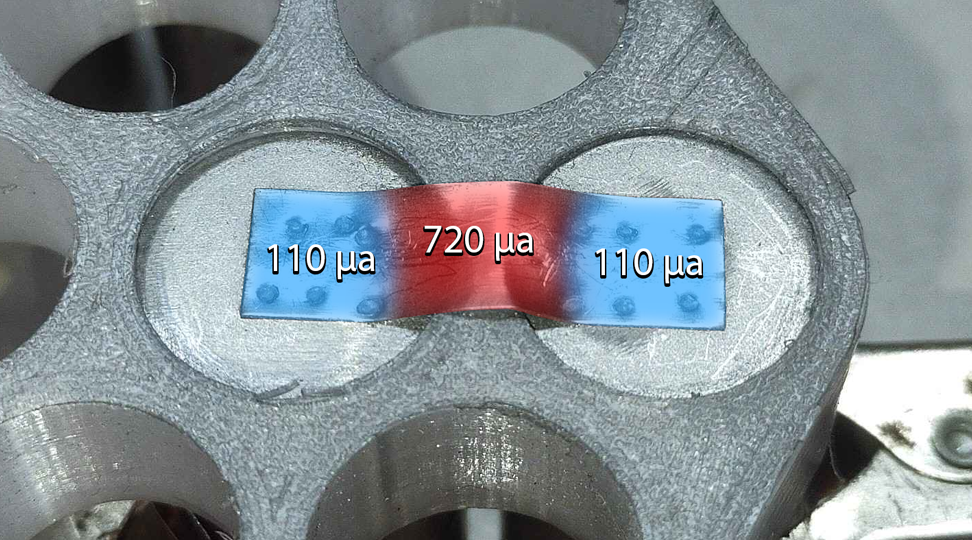
How to Install Dual Batteries on an Ebike
Table of Contents
If you have an ebike and have been wanting more range or speed, you might be wondering how to install dual batteries on your ebike. There are a couple of ways this can be done and some are more viable than others.
When connecting dual ebikes in series, you have to connect the positive of the first battery to the negative of the second battery. After that, connect the remaining free positive and negative connections to the ebike speed controller. All ebike batteries should have a BMS, and problems can arise when running 2 ebike batteries in series. This is because the MOSFETs in the BMS are not going to be rated for the full battery voltage of both packs. Under normal operation, this is not a problem as the voltage across the MOSFETs on both battery packs is close to zero. When one battery dies, however, its MOSFETs will switch into a high resistance state. When this happens, those MOSFETs will experience the voltage of the still working battery and the voltage of the dead cells in the dead battery. In most cases, this will overvolt the MOSFETs in the BMS of the dead battery.
When connecting dual ebike batteries in parallel, you have to connect the positive from the first battery to the positive of the second battery. After that, you can connect the speed controller to either battery. It’s important for the batteries to be at the same voltage before connecting them. If they are not, then a large amount of current will flow from the higher voltage battery to the lower voltage battery. Even if the batteries are at the same voltage when you connect them and everything seems to work fine, its not good to put two batteries of different capacities in parallel. This causes the batteries to be in an imbalanced state of discharge and makes it so the larger battery is always charging the smaller battery at an unpredictable rate. This puts extra strain on everything and reduces the life of the batteries. People usually don't notice because there is still a net gain in capacity from adding the second battery, but it's really reducing the overall life of the system.
In this article, we will go over how to install dual batteries on an ebike. We will also explain the pros and cons for each setup, and when to not do each one.
Installing Dual Batteries In Series
So, a lot of people are wanting to know if it’s possible to wire 2 36V ebike batteries in series to make a 72V battery. Wiring up two batteries to make a 72V setup is technically possible, but it is not recommended. The main concern is the Battery Management System (BMS) and what voltage its components are rated for. A BMS controls access to the battery via n-Channel MOSFETs, which are rated for a particular voltage that is some amount higher than the voltage they are used for. For example, the MOSFETs in a 36V BMS are generally rated for 45+ volts.
The problem arises when one of the batteries in the series fails, causing the MOSFETs in the dead battery to be exposed to a voltage that exceeds their rating. This can lead to damage to the BMS in the dead battery and, in rare cases, even a fire. To avoid these issues, it's important to take great care to ensure that neither battery dies.
Using a BMS is necessary as it provides a safety measure for lithium batteries, so bypassing one or both BMS to get around this problem is not a viable solution. However, if you take the necessary precautions and ensure that neither battery dies, it is possible to wire up two batteries to make a 72V setup.
It is possible to tie discharge gate control pins on each BMS together with a wire, but this is an advanced procedure that requires modifying both BMS. Another thing to consider is the voltage differential between two gate pins associated with 2 BMSs in series. There will more than likely be a dangerous difference between the two, so in addition to all the other work, isolation circuitry would have to be employed.
Consider The Rest Of The System
Watts equals volts times amps. If you have an ebike controller that is limited to 30 amps and you have a 48V battery, then how many watts is that?
36 Volts x 30 Amps = 1080 Watts
So, what happens if you double your system voltage by putting two 36V batteries in series?
72 Volts x 30 Amps = 2160 Watts
So, if the controller supports it, then you will get twice the power out of the controller. But only if you want twice the power. The thing about running a higher voltage on an ebike is that you can choose how much of that power to use. So, if you combine two batteries and adjust your power level to half of what it was before, you will have the same 1080 Watt limit at a higher running voltage.
But remember, Watts is Volts times Amps, which means that Amps is Watts divided by Volts. So let's do the math to find out how many amps would be required to run a 72V load at 1080 Watts.
1080 Watts ÷ 72 Volts = 15 Amps
This means that you can get all the power you were used to while putting your batteries under half the stress as was required before. This will result in a much longer overall battery lifespan and will provide an excellent buffer against voltage sag.
Installing Dual Batteries In Parallel
It is possible to wire two ebike batteries in parallel to increase capacity and it is much safer and much more tolerant to error than wiring them in series, as it eliminates the risk of overvoltage damage to the BMS.
When wiring two ebike batteries in parallel, it is important to ensure that the batteries are of the same type, and capacity and that they are rated for the same voltage. This is because if one battery is larger than the other, it will more than likely have lower internal resistance and will provide more than its fair share of the load current.
This will lead to an imbalance in the system that will be quickly and unpredictably corrected by a rush of current from the larger battery to the smaller one on every discharge. This can damage both batteries and if the wiring between the two can't support the higher currents, it could start a fire.
When doing this, you have to make sure that the positive and negative terminals of each battery must be connected to the same terminals on the other battery. Before connecting the two packs together both packs need to be at the same voltage, within .1v of each ideally. If this is not done correctly, it will cause a short circuit, which can cause burns and/or ruin one or both batteries.
Consider The Rest Of The System
When adding two batteries in parallel, whether they are properly matched or not, the rest of the system doesn't know any different. It will see the same running voltage and power will be applied as normal. It is worth mentioning, however, that because there is another battery there to share the load, each battery will bear less of the load than it otherwise would have had it been the only battery in operation.
This helps to extend the life of the batteries and works against the face that if the batteries are mismatched, overall life is reduced. This situation ends up creating somewhat of a balance that produces an overall net-positive effect when adding batteries in parallel, even if they are mismatched. This is why many people swear by this method and say that it works perfectly.
Simple Way To Install Dual Batteries On An Ebike
The best way to use multiple batteries on an ebike is to put them in parallel. This is only truly viable if you have two matched batteries, though. If the batteries are not matched, the best thing you can do is use a switch to toggle between them. The problem is that switches that can handle that amount of current are often expensive and bulky. So, the simple solution is a manual one.
When your first battery dies, simply unplug it and plug the other battery in. All you have to do to make this possible is to run the wiring in the right places on your bike and put the connections in the most ideal spots for you to switch them.
Swapping over a cable into another port is a quick, painless procedure and it is the easiest, most effective, and safest way to install dual batteries on your ebike. The only downside is the fact that it is not automatic and requires the bike to stop for a moment. This is a more than worthy tradeoff, considering its low cost and simplicity.
There are also battery discharge combiner modules, but it is important to keep in mind that they often have relatively low current limits. For example, the first listing for the linked battery combiner specifically says to not use it with a non-geared motor. This is because without gears, starting from 0 uses quite a bit of power. Whereas the second one does not have that noted since it can handle higher amperage.
[[ aff type=aff ~ link=https://amzn.to/3FsO8kx ~ title=`Dual Battery Pack Balancer` ~ image=https://admin.cellsaviors.com/storage/dual-battery-balancer.jpg ~ description=`Perfect for applications using 40A or less this will easily allow you to parallel two batteries. ` ~ height=small ~ buttonText=`Check Price` ]]
[[ aff type=aff ~ link=https://amzn.to/3TmYqZa ~ title=`100A Dual Battery Balancer` ~ image=https://admin.cellsaviors.com/storage/100A-dual-battery-balancer.jpg ~ description=`This will work up to 100A and in the 24-72v range, much better for higher output applications!` ~ height=small ~ buttonText=`Check Price` ]]
Consider The Rest Of The System
This is the least invasive way to add dual batteries to an ebike in terms of system characteristics. This is because the batteries are not connected at the same time, so all the precocious and disclaimers above go out the window. In fact, because the batteries are totally isolated and never used together, you can even confidently mismatch different voltages, capacities, and even cell chemistries.
You could have an LFP pack for short runs as they have an extended cycle life and you could have an NMC pack for long range as they have the highest energy density. You could have a large, 48V pack for long runs and you could have a small, 72V back for short races on a track or other closed circuit. The possibilities are endless because the batteries are never connected at the same time. As long as your controller supports the voltage of whatever battery you plan on connecting to it, it will be fine.
Conclusion
Installing dual batteries on your ebike can be a great way to increase its range and speed. However, the method of connecting the batteries is crucial to ensure safe and reliable operation. Connecting the batteries in series involves connecting the positive of the first battery to the negative of the second battery, and then connecting the remaining connections to the speed controller. However, problems can arise if the batteries are not matched and one battery dies, which can overvolt the BMS in the dead battery.
On the other hand, connecting the batteries in parallel involves connecting the positive of the first battery to the positive of the second battery, and then connecting the speed controller to either battery. It's important for the batteries to be at the same voltage before connecting them, and to avoid putting two batteries of different capacities in parallel as it can cause an imbalanced state of discharge and reduce the life of the system.
We hope this article contained everything you wanted to know about how to install dual batteries on your ebike, thanks for reading!


